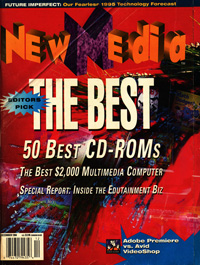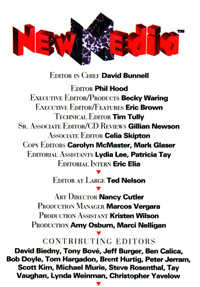|
Vaughan Family Timestream® Maps |
| Home Biography People Places Multimedia: Making It Work On the Water Writings/Presentations |
Ask the Captain
August, 1993
From "Ask the Captain," a monthly column by Tay Vaughan.
New Media Magazine.
Q. Dear Captain: Your May column may have deep-sixed the lady from Hawaii if she doesn't feed a signal into her recorder when black-striping videotape. A "blackened" tape is used when editing in insert-mode to provide an uninterrupted control track signal in the finished program. A capped camera with the mike disconnected is the simplest source, but inexpensive black-burst generators are also available.
-- Dick Madding, Dayton, OH
A. Use Method 2 from the May column to black-stripe your video tapes: you need a signal, so run your tape with the video and audio inputs connected, and follow Dick Madding's suggestion above about capping the lens and disconnecting the mike. Rick Gregory of Broadcast Digital Systems writes that recording "...without video input would provide noise with untimed control track - just the opposite of what someone would want," and.Len Schneiderman of ABC News Interactive offers that "...running your tape through the VTR with no video connected might result in an off-speed control track... I've seen too many people try to record an audio-only narration this way and have it unplayable in our edit suites." T-shirts to all for nailing this alligator!
---
Q. Perhaps you could investigate why Digidesign no longer supports Audiomedia cards for use on the Centris 610 & 650 or the Quadra 800. While many other Nubus card manufacturers are moving up to the newer Macs, Digidesign is asking us to abandon a significant investment..."
-- R.J.Miles, Wilmington, DE
A. Digidesign's Audiomedia card is a 16-bit stereo NuBus card designed for professional CD-Audio digitizing and editing on the Macintosh. It works hand-in-hand with Sound Designer II editing software, also from Digidesign. According to Andrew Calvo, Audiomedia product manager, the original board was engineered four years ago, and there are timing difficulties with some of Apple's new CPUs. So Digidesign reengineered the hardware into the Audiomedia II board - list price $1295, but available for $999 from Apple through the latest Apple Catalog (800-795-1000). This works in the Centris 650 and the Quadra 800, but not in the Centris 610, which can fit only 7-inch NuBus boards (the Audiomedia board is 9 inches, and Digidesign has no plans for a major redesign into a shorter configuration).
About your investment, I am sorry to hear you complain. Indeed, given the pace of this industry, fours years is a pretty long lifespan for the original Audiomedia hardware! If you want to surf at the leading edge, you must be prepared for constant changes in hardware and software and for the concommitant expense. Perhaps you should not buy the new Quadra 800 and throw away your old Audiomedia board, but rather float quietly on the back-side of the wave, where you know the hardware is tested, stable, and paid-for. You can't have it both ways.
---
Q. We have created a multimedia project in our 8th grade computer class, and would like to send it to our sister school in France as a surprise. How can we be sure they will be able to play it there?
Suzanne Dupre, Miami, FL
A. First, you need matching hardware: if your project runs on a Macintosh, they will need a Macintosh; if it runs on a PC with Windows, they will need a PC with Windows. Then you need matching system configurations and software: if your project requires 4MB of RAM, their computer with 2MB may fail. If you use special tools like QuickTime or Microsoft Video for Windows, they will need these tools in France as well - or you will need to include them with your project. These are the same considerations you would have if you sent your project to a sister school within the USA.
The good news is that the same tools and computer platforms you use for making multimedia in the USA are widely available and used abroad, most often "localized" to the native language of that country. The operating systems for Macintosh, DOS, Windows, Atari, and Commodore, for example, have been translated into most foreign languages.
If you intend to convert your project into French as part of your surprise, beware that French and many other languages are more verbose than English - it takes more words and letters in French to say the same thing when translated from English, so your text may no longer fit on the screen or it may wrap right out of its text field.
For readers who may need commercial localizing and translation, at least one company has sprung up in San Francisco that specializes in providing multi-lingual multimedia voice and acting talent as well as localization of projects to more than a dozen languages (International Voice Talent & Casting - 415-775-7349).
Let us know how your surprise works out!
Send your questions to TAY c/o NewMedia, 901 Mariner's Island Blvd., Suite 365, San Mateo, Calif. 94404 or send a fax to (415) 573-5131. Writers of published questions will receive a NewMedia T-shirt and prompt answers to their questions. Tay is president of Timestream, Inc,. a CD-ROM and multimedia title production and publishing company, and is author of Multimedia: Making It Work, (Osborne/McGraw-Hill).

